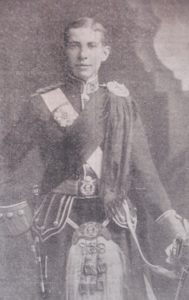The Late Captain Alexander D.L. Stewart M.C., Yr. Of Achnacone, Appin. Oban Times 1920


His Military Career
Captain Stewart, born in 1891, was educated at Cheltenham, and was gazetted from Sandhurst to th 1st Gordon Highlanders, September 20, 1911. This fine Regiment was one of the first to go to France in 1914, and was heavily engaged at Mons, and subsequently at Le Cateau, when, through a miscarriage of orders, they were left behindCaptain Alexander Stewart M.C holding their position in face of the enemy until midnight, August 26, ten hours after the whole British force had left the field. In the retreat that then commenced, and in the early hours of the morning, the Regiment ran into a body of the enemy in the dark and severe hand to hand fighting at close quarters ensued, in which Captain Stewart took a very prominent and leading part, young as he was, until the order to surrender was issued. The officer in command of the mixed force testified to his killing four Germans at the outset who had got him down, thus saving his life. Captain Stewart then emptied his revolver into a black mass of Germans at six yards range, firing below the flashes of enemy rapid fire that was then proceeding. Having assisted to secure and organise that end of the attack, he then proceeded to the other end, and on the way killed more Germans, among them a Felt Webel. Arriving, he found the position held up by fire from a house full of Germans. With unhesitating gallantry, he broke into the house in company with another officer, Lieut. Lyon, and in the fierce struggle that ensued Lieut. Lyon was shot through the chest at the same time that Captain Stewart blew off the head of his assailant, a powerful Felt Webel, and when he also killed two other men before the door was slammed to. Removing Lieut. Lyon out of the house in a dying condition, he ordered his men to fire into the windows, while he himself re-entered, single handed, killing two more Germans, and thus clearing the house and establishing the position. Finally, and with Lieut. The Master of Saltoun, he carried on to the obviously dangerous order to convey the surrender of the Regiment to the Germans by advancing into the darkness of the night in face of an excited enemy. For this action he was strongly recommended for the Victoria Cross, and there will be regret among both officers and men that the decoration confidently anticipated by them as having been unmistakably earned has not been granted.
A Prisoner of War in Germany
While in Germany he was one of the famous, and now historic, submarine reprisal prisoners, and underwent a long term of solitary confinement – by no means his only experience of that kind. He twice effected his escape in company with Lieut. Medlicott, R.A.F. who was subsequently killed in a further attempt to escape. On the first occasion he escaped on April 13, 1916, from Weilburg, where he was compelled to strangle into insensibility a Belgian General, who persisted in trying to alarm the guard. They were at large for four days, which were full of adventure and hardship from exposure, when they discovered a Zeppelin shed and were chased and fired at. They were finally robbed, by Nature alone, of the distinction when the opportunity was
Imprisoned by court martial they were confined in the civil prison of Friedberg with sentries over them. But here again they broke out before the sentence was expired by surmounting the very high wall of 16 feet under the very nose of the sentry, and who was fumbling with the bolt of his rifle as Captain Stewart dropped over the top into a crowd of Germans in the street, who took them for cinema actors.
Digging the “Garros” Tunnel.
From there he was transported to Fort Zorndorf for safe keeping, to the far Prussian frontier, where he was confined for seventy-seven days inside walls; and he was one of those who assisted in the digging of the famous “Garros” tunnel, the ventilation in which was so bad that they had to knock a hole in the sewer to improve matters. From Fort Zorndorf Captain Stewart was transferred to Osnabruck; and being considered in the light of a natural leader, he was confronted with the problem of a French officer spy among the prisoners. He convened a meeting, and the evidence not being considered sufficient for the death sentence, it was decided to frighten him out of the place. At 11.15 one night, therefore, armed with water mixed with ashes, treacle, jam and ink, the spy was plentifully anointed when in bed, to his great alarm and fear for his life. At the Court Martial, Captain Stewart was fined five hundred marks, though the two senior French Commandants gave strong evidence in his favour.
“He Knew No Fear”
An officer, writing of his character, who knew him as a prisoner at Custrin, Fort Zorndorf, and in other camps, says:-“He felt the strain of Custrin imprisonment very much, and there and elsewhere he was always going for the Germans for improved conditions generally, or for the righting of the wrongs of his friends. But in every camp he was in even the Germans could not help liking and holding him high.”
This impetuous, fearless character was what endeared him to all who knew him and called forth the invariable remark that he knew no fear.
Captain Stewart, very shortly before his death, was transferred to the 2nd Battalion in Dublin, and here he earned high commendation from his commanding officer, who, recognising his abilities early selected him for important work in that disturbed locality.
His Family Descent
The stock from which Captain Stewart claimed descent has probably had more fighting than any in the annals of Scotland. The Stewarts of Appin, of which Achnacone is the senior cadet branch, descend through the Stewarts, Lords of Lorn, through Sir James Stewart of Pierston and Warrick Hill, fourth son of Sir John Stewart of Bonkyl, second son of Alexander, 6th High Steward of Scotland, whose elder son was ancestor of the Royal Stewarts, and thus through Fleanch and Banquo to Fergus 1st and the ancient Kings of Scotland- all fighting names to conjure with. They also inherit the blood of Bruce and of the more modern Royal Stewarts through female connections. Hogg, the Ettrick Shepherd, sings of them as “The brave and the few,” and “The Bravest of all”; while further back still, in “The Scottish Nobilitie in An.Dom., 1577,” per Alex. Hay, they are thus referred to as “The best sort of Stewarts, called the Stewarts of Lorne, whereof be now a few yet valiant” – a unique description.
Captain Stewart is succeeded by his brother, Captain Ian Macalister Stewart, M.C., Argyll and Sutherland Highlanders, who is now younger of Achnacone, and who has been lately awarded a bar to his MC.
Article from The Oban Times 1920




2 Comments
Really interesting especially finding family christian names that have been used over the generations.
I am descended from the families of Stewart on my mothers side and McColl on my fathers side.
I have family photographs of early Appin and have been visited unexpectedly by family from Appin who brought the same photographs that I have with them.
Hello, thank you for finding this information, my name is Samantha Stewart, I come from the Stewart’s of Appin. This is my fathers great uncle Alec. Thank you for sharing this article. I came across this page and kept thinking captain Stewart looks like the men on my families side, they all have a strong resemblance of one another. So I fact checked with my father and turns out captain Stewart is a family member of mine, my eldest uncle still has some of his medals.
Thank you for this, I hope to link in with some family, so if anybody could push me in the right direction I’d be very grateful.